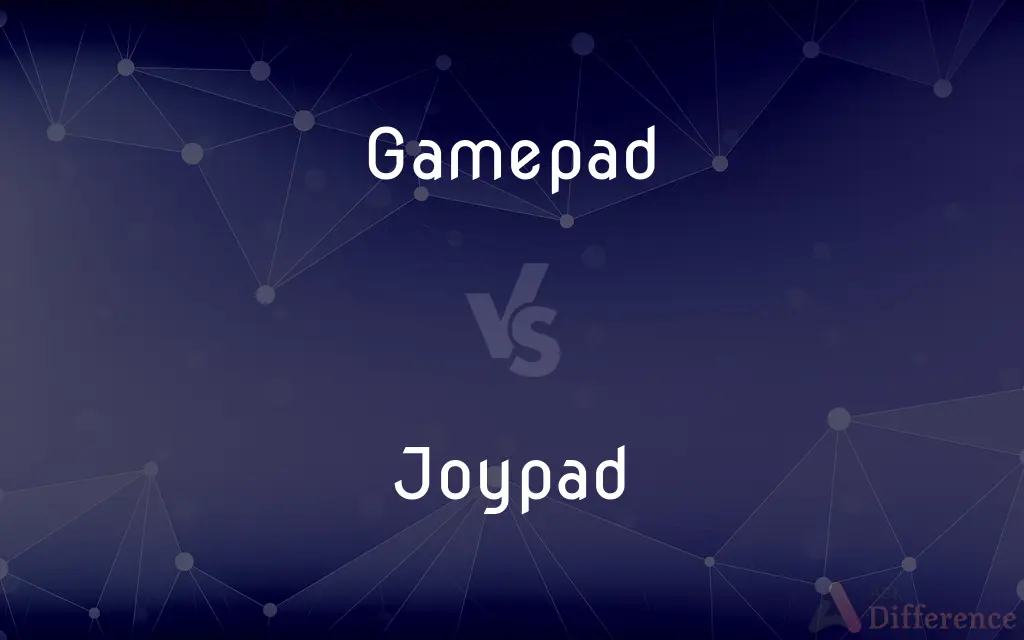Gamepad vs. Joypad — What's the Difference?
Edited by Tayyaba Rehman — By Urooj Arif — Updated on March 20, 2024
A gamepad is a type of controller for video games that is held in both hands, featuring buttons and directional controls, while a joypad is often used interchangeably with gamepad, especially in older gaming contexts or specific regions.

Difference Between Gamepad and Joypad
Table of Contents
ADVERTISEMENT
Key Differences
Gamepads are versatile input devices designed for video gaming, incorporating an ergonomic shape to fit comfortably in the hands, along with a combination of analog sticks, directional pads (D-pads), buttons, and sometimes additional features like vibration feedback and motion sensors. On the other hand, the term "joypad" is less commonly used in contemporary gaming language but generally refers to the same type of device, with its usage more prevalent in earlier gaming generations or in certain geographical areas.
Both gamepads and joypads serve the primary function of providing players with a means to interact with video games, offering a range of controls for different types of gameplay. While "gamepad" is the more universally accepted term today, "joypad" might still be found in discussions about older console generations or within specific gamer communities.
The development of gamepads over time has seen them evolve from simple designs with a minimal number of buttons and a single directional control, to complex, multifunctional devices capable of a wide range of inputs. Joypads, as they were referred to in earlier years, laid the groundwork for this evolution, with their design principles still influencing modern gamepad design.
In modern usage, when distinguishing between these terms is necessary, it might come down to regional preferences or the context in which they were introduced. For example, in some European countries, the term "joypad" was more commonly used during the 80s and 90s. Regardless of the term, the fundamental purpose and design of these devices have remained consistent, focusing on improving player interaction and comfort during gaming.
The convergence in the design and functionality of gamepads and joypads illustrates the standardization in video game controllers, with differences more related to terminology than to technology or functionality. Both are essential tools for gamers, providing the interface needed to bridge the physical world with the virtual gaming experience.
ADVERTISEMENT
Comparison Chart
Definition
A controller for video games held in both hands, featuring a mix of buttons and directional controls.
Often synonymous with gamepad, used to describe similar controllers, especially in earlier gaming contexts.
Usage
Universal term for modern gaming controllers.
Used interchangeably with gamepad, more common in older contexts or certain regions.
Components
Analog sticks, D-pad, buttons, triggers, and sometimes motion sensors or vibration feedback.
Similar to gamepad, but might refer to simpler, earlier versions without modern features like motion sensors.
Evolution
Evolved from simple designs to complex, multifunctional devices.
The foundational design for modern gamepads, with less emphasis on advanced features.
Regional Preference
Preferred term in most current global discussions about gaming controllers.
Usage might still be prevalent in certain areas or among fans of retro gaming.
Compare with Definitions
Gamepad
Features a variety of controls.
Modern gamepads include analog sticks, a D-pad, multiple buttons, and triggers for comprehensive game control.
Joypad
Reflects gaming's evolution.
Joypads represent an earlier stage in the evolution of game controllers, leading to today's multifunctional gamepads.
Gamepad
Integral to modern gaming.
Gamepads are central to the gameplay experience across many genres and platforms.
Joypad
Regional terminology variations.
In some regions, gamers might still refer to their controllers as joypads out of habit or preference.
Gamepad
Ergonomically designed for comfortable use.
The gamepad's ergonomic design ensures comfort during long gaming sessions.
Joypad
Nostalgic significance.
Retro gaming enthusiasts often treasure joypads for their simplicity and historical value in gaming culture.
Gamepad
Used across gaming platforms.
Gamepads are compatible with consoles, PCs, and even mobile devices through various connection methods.
Joypad
Often simpler in design.
Early joypads were straightforward, focusing on basic gameplay interaction without extra features.
Gamepad
Supports advanced features.
Some gamepads offer vibration feedback and motion sensing for an immersive gaming experience.
Joypad
Historically used term for game controllers.
The joypad of the early gaming console provided basic control with a D-pad and buttons.
Gamepad
A gamepad, joystick, controller, is a type of game controller held in two hands, where the fingers (especially thumbs) are used to provide input. They are typically the main input device for video game consoles.
Joypad
(video games) A type of game controller held in the hand, where the digits (especially thumbs) are used to provide input.
Gamepad
(video games) A type of game controller held in both hands and controlled with the thumbs.
Common Curiosities
Why do some people still use the term joypad?
The term joypad might be used due to regional preferences, nostalgia, or because it was more prevalent during the individual's early gaming experiences.
Is there a difference between a gamepad and a joypad?
The terms gamepad and joypad are often used interchangeably, with "joypad" being more common in earlier gaming contexts or certain regions.
What is a gamepad?
A gamepad is a handheld controller used for video games, featuring a combination of buttons and directional controls.
How do gamepads impact the accessibility of video games?
Gamepads can enhance accessibility by providing customizable controls and layouts that accommodate different physical needs, making games more accessible to a wider audience.
What features do modern gamepads have?
Modern gamepads may include analog sticks, a D-pad, multiple buttons, triggers, vibration feedback, and motion sensors.
Can gamepads be used on different types of gaming platforms?
Yes, gamepads can be used across various platforms, including consoles, PCs, and mobile devices, often requiring specific compatibility or adapters.
Can joypads be considered collectible items?
Yes, joypads, especially those from classic gaming consoles, are considered collectible items by retro gaming enthusiasts and collectors.
What is the significance of the analog sticks on a gamepad?
Analog sticks provide precise, multidirectional control over movement and camera angles in games, offering more nuanced control compared to digital D-pads.
How have gamepads evolved over time?
Gamepads have evolved from simple designs with minimal buttons to complex devices capable of a wide range of inputs and interactions.
Are all gamepads wireless?
Not all gamepads are wireless; many models offer wired connections, while newer ones often provide both wired and wireless connectivity options.
How do vibration feedback and motion sensors enhance gaming with a gamepad?
Vibration feedback and motion sensors enhance gaming by providing tactile feedback and allowing physical movements to be reflected in-game, offering a more immersive experience.
Are there specific game genres that benefit more from using a gamepad?
Yes, game genres such as racing, platformers, action/adventure, and sports often benefit from the intuitive control schemes and ergonomic design offered by gamepads.
How has the introduction of gamepads influenced the development of video games?
The introduction of gamepads has influenced game development by allowing designers to create more complex and engaging control schemes, leading to richer and more immersive gaming experiences.
How do ergonomic designs in gamepads affect gaming sessions?
Ergonomic designs in gamepads reduce hand and wrist strain during extended gaming sessions, improving comfort and preventing fatigue.
What are some key factors to consider when choosing a gamepad?
Key factors include compatibility with your gaming platform, ergonomic design, button layout, wired or wireless connectivity, and any additional features like motion sensors or vibration feedback.
Share Your Discovery

Previous Comparison
Protist vs. Protoctist
Next Comparison
Olio vs. StewAuthor Spotlight
Written by
Urooj ArifUrooj is a skilled content writer at Ask Difference, known for her exceptional ability to simplify complex topics into engaging and informative content. With a passion for research and a flair for clear, concise writing, she consistently delivers articles that resonate with our diverse audience.
Edited by
Tayyaba RehmanTayyaba Rehman is a distinguished writer, currently serving as a primary contributor to askdifference.com. As a researcher in semantics and etymology, Tayyaba's passion for the complexity of languages and their distinctions has found a perfect home on the platform. Tayyaba delves into the intricacies of language, distinguishing between commonly confused words and phrases, thereby providing clarity for readers worldwide.














































